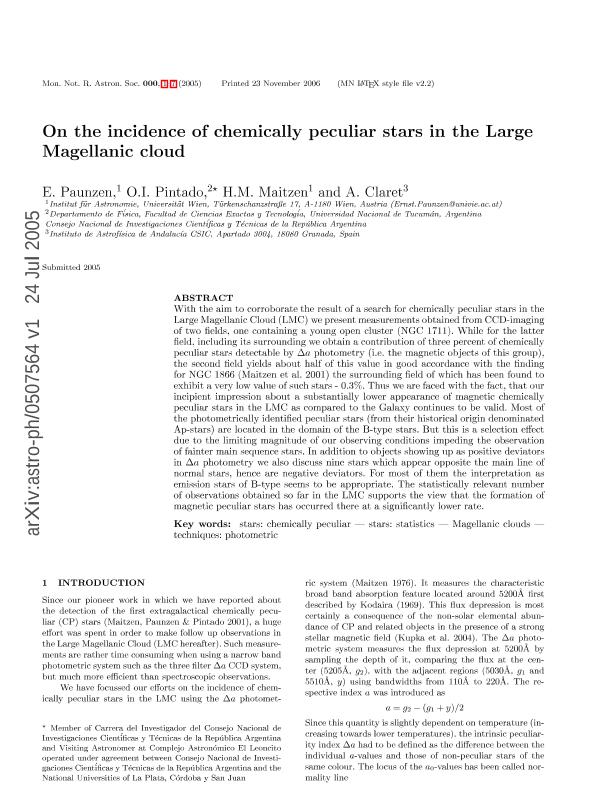Mostrar el registro sencillo del ítem
dc.contributor.author
Paunzen, E.
dc.contributor.author
Pintado, Olga Ines

dc.contributor.author
Maitzen, H. M.
dc.contributor.author
Claret Dos Santos, Antonio

dc.date.available
2020-03-19T17:48:32Z
dc.date.issued
2005-09
dc.identifier.citation
Paunzen, E.; Pintado, Olga Ines; Maitzen, H. M.; Claret Dos Santos, Antonio; On the incidence of chemically peculiar stars in the Large Magellanic Cloud; Oxford University Press; Monthly Notices of the Royal Astronomical Society; 362; 3; 9-2005; 1025-1030
dc.identifier.issn
0035-8711
dc.identifier.uri
http://hdl.handle.net/11336/100280
dc.description.abstract
With the aim to corroborate the result of a search for chemically peculiar stars in the Large Magellanic Cloud (LMC), we present measurements obtained from CCD imaging of two fields, one containing a young open cluster (NGC 1711). While for the latter field, including its surrounding we obtain a contribution of 3 per cent of chemically peculiar stars detectable by Δa photometry (i.e. the magnetic objects of this group), the second field yields about half of this value in good accordance with Maitzen et al.'s finding for NGC 1866, the surrounding field of which has been found to exhibit a very low value of such stars (0.3 per cent). Thus, we are faced with the fact that our incipient impression about a substantially lower appearance of magnetic chemically peculiar stars in the LMC as compared to the Galaxy continues to be valid. Most of the photometrically identified peculiar stars (from their historical origin denominated Ap stars) are located in the domain of the B-type stars. However, this is a selection effect due to the limiting magnitude of our observing conditions impeding the observation of fainter main-sequence stars. In addition to objects showing up as positive deviators in Δa photometry, we also discuss nine stars which appear opposite the main line of normal stars, and hence are negative deviators. For most of them, the interpretation as emission stars of B-type seems to be appropriate. The statistically relevant number of observations obtained so far in the LMC supports the view that the formation of magnetic peculiar stars has occurred there at a significantly lower rate.
dc.format
application/pdf
dc.language.iso
eng
dc.publisher
Oxford University Press

dc.rights
info:eu-repo/semantics/openAccess
dc.rights.uri
https://creativecommons.org/licenses/by-nc-sa/2.5/ar/
dc.subject
MAGELLANIC CLOUDS
dc.subject
STARS: CHEMICALLY PECULIAR
dc.subject
STARS: STATISTICS
dc.subject
TECHNIQUES: PHOTOMETRIC
dc.subject.classification
Astronomía

dc.subject.classification
Ciencias Físicas

dc.subject.classification
CIENCIAS NATURALES Y EXACTAS

dc.title
On the incidence of chemically peculiar stars in the Large Magellanic Cloud
dc.type
info:eu-repo/semantics/article
dc.type
info:ar-repo/semantics/artículo
dc.type
info:eu-repo/semantics/publishedVersion
dc.date.updated
2020-03-11T18:34:35Z
dc.journal.volume
362
dc.journal.number
3
dc.journal.pagination
1025-1030
dc.journal.pais
Reino Unido

dc.journal.ciudad
Oxford
dc.description.fil
Fil: Paunzen, E.. Universidad de Viena; Austria
dc.description.fil
Fil: Pintado, Olga Ines. Consejo Nacional de Investigaciones Científicas y Técnicas; Argentina. Universidad Nacional de Tucumán. Facultad de Ciencias Exactas y Tecnología. Departamento de Física; Argentina
dc.description.fil
Fil: Maitzen, H. M.. Universidad de Viena; Austria
dc.description.fil
Fil: Claret Dos Santos, Antonio. Instituto de Astrofísica de Andalucía; España. Consejo Superior de Investigaciones Científicas; España
dc.journal.title
Monthly Notices of the Royal Astronomical Society

dc.relation.alternativeid
info:eu-repo/semantics/altIdentifier/doi/http://dx.doi.org/10.1111/j.1365-2966.2005.09371.x
dc.relation.alternativeid
info:eu-repo/semantics/altIdentifier/url/https://academic.oup.com/mnras/article/362/3/1025/976364
dc.relation.alternativeid
info:eu-repo/semantics/altIdentifier/url/https://arxiv.org/abs/astro-ph/0507564
Archivos asociados
